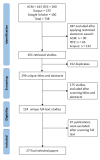Telehealth interventions during COVID-19 pandemic: a scoping review of applications, challenges, privacy and security issues
- PMID: 37541739
- PMCID: PMC10407386
- DOI: 10.1136/bmjhci-2022-100676
Telehealth interventions during COVID-19 pandemic: a scoping review of applications, challenges, privacy and security issues
Abstract
Background: The COVID-19, caused by the SARS-CoV-2 virus, proliferated worldwide, leading to a pandemic. Many governmental and non-governmental organisations and research institutes are contributing to the COVID-19 fight to control the pandemic.
Motivation: Numerous telehealth applications have been proposed and adopted during the pandemic to combat the spread of the disease. To this end, powerful tools such as artificial intelligence (AI)/robotic technologies, tracking, monitoring, consultation apps and other telehealth interventions have been extensively used. However, there are several issues and challenges that are currently facing this technology.
Objective: The purpose of this scoping review is to analyse the primary goal of these techniques; document their contribution to tackling COVID-19; identify and categorise their main challenges and future direction in fighting against the COVID-19 or future pandemic outbreaks.
Methods: Four digital libraries (ACM, IEEE, Scopus and Google Scholar) were searched to identify relevant sources. Preferred Reporting Items for Systematic reviews and Meta-Analyses extension for Scoping Reviews (PRISMA-ScR) was used as a guideline procedure to develop a comprehensive scoping review. General telehealth features were extracted from the studies reviewed and analysed in the context of the intervention type, technology used, contributions, challenges, issues and limitations.
Results: A collection of 27 studies were analysed. The reported telehealth interventions were classified into two main categories: AI-based and non-AI-based interventions; their main contributions to tackling COVID-19 are in the aspects of disease detection and diagnosis, pathogenesis and virology, vaccine and drug development, transmission and epidemic predictions, online patient consultation, tracing, and observation; 28 telehealth intervention challenges/issues have been reported and categorised into technical (14), non-technical (10), and privacy, and policy issues (4). The most critical technical challenges are: network issues, system reliability issues, performance, accuracy and compatibility issues. Moreover, the most critical non-technical issues are: the skills required, hardware/software cost, inability to entirely replace physical treatment and people's uncertainty about using the technology. Stringent laws/regulations, ethical issues are some of the policy and privacy issues affecting the development of the telehealth interventions reported in the literature.
Conclusion: This study provides medical and scientific scholars with a comprehensive overview of telehealth technologies' current and future applications in the fight against COVID-19 to motivate researchers to continue to maximise the benefits of these techniques in the fight against pandemics. Lastly, we recommend that the identified challenges, privacy, and security issues and solutions be considered when designing and developing future telehealth applications.
Keywords: COVID-19; global health; health information systems; medical informatics applications; telemedicine.
© Author(s) (or their employer(s)) 2023. Re-use permitted under CC BY-NC. No commercial re-use. See rights and permissions. Published by BMJ.
Conflict of interest statement
Competing interests: None declared.
Figures



Similar articles
-
Adoption of Digital Technologies in Health Care During the COVID-19 Pandemic: Systematic Review of Early Scientific Literature.J Med Internet Res. 2020 Nov 6;22(11):e22280. doi: 10.2196/22280. J Med Internet Res. 2020. PMID: 33079693 Free PMC article.
-
REVISITING HEALTH INFORMATION TECHNOLOGY ETHICAL, LEGAL, and SOCIAL ISSUES and EVALUATION: TELEHEALTH/TELEMEDICINE and COVID-19.Int J Med Inform. 2020 Nov;143:104239. doi: 10.1016/j.ijmedinf.2020.104239. Epub 2020 Jul 31. Int J Med Inform. 2020. PMID: 33152653 Free PMC article. Review.
-
Data Privacy, Regulations and Legal Issues on COVID-19 Tracking Apps: A Scoping Review.Stud Health Technol Inform. 2022 Jan 14;289:388-391. doi: 10.3233/SHTI210940. Stud Health Technol Inform. 2022. PMID: 35062173
-
Health Apps for Combating COVID-19: Descriptive Review and Taxonomy.JMIR Mhealth Uhealth. 2021 Mar 2;9(3):e24322. doi: 10.2196/24322. JMIR Mhealth Uhealth. 2021. PMID: 33626017 Free PMC article. Review.
-
Citizen-Centered Mobile Health Apps Collecting Individual-Level Spatial Data for Infectious Disease Management: Scoping Review.JMIR Mhealth Uhealth. 2020 Nov 10;8(11):e22594. doi: 10.2196/22594. JMIR Mhealth Uhealth. 2020. PMID: 33074833 Free PMC article.
Cited by
-
Empowering tomorrow's public health researchers and clinicians to develop digital health interventions using chatbots, virtual reality, and other AI technologies.Front Public Health. 2025 Jul 8;13:1577076. doi: 10.3389/fpubh.2025.1577076. eCollection 2025. Front Public Health. 2025. PMID: 40697845 Free PMC article.
-
Patient-Generated Images in Perianal Disease: An Evolving Tool in Proctology.Clin Exp Gastroenterol. 2024 Aug 8;17:255-259. doi: 10.2147/CEG.S466984. eCollection 2024. Clin Exp Gastroenterol. 2024. PMID: 39139370 Free PMC article.
-
Impacts of the Early COVID-19 Response on Allied Health Staff Within an Australian Tertiary Health Service: A Qualitative Study.J Multidiscip Healthc. 2023 Dec 6;16:3833-3846. doi: 10.2147/JMDH.S428710. eCollection 2023. J Multidiscip Healthc. 2023. PMID: 38084120 Free PMC article.
-
Exploring Augmented Reality Integration in Diagnostic Imaging: Myth or Reality?Diagnostics (Basel). 2024 Jun 23;14(13):1333. doi: 10.3390/diagnostics14131333. Diagnostics (Basel). 2024. PMID: 39001224 Free PMC article. Review.
-
Artificial Intelligence and Healthcare: A Journey through History, Present Innovations, and Future Possibilities.Life (Basel). 2024 Apr 26;14(5):557. doi: 10.3390/life14050557. Life (Basel). 2024. PMID: 38792579 Free PMC article. Review.
References
-
- Chen J, Li K, Zhang Z, et al. . A survey on applications of artificial intelligence in fighting against COVID-19. ACM Comput Surv 2022;54:1–32. 10.1145/3465398 - DOI
-
- WorldMeter . World meters information - Corona virus cases. 2021. Available: https://www.worldometers.info/coronavirus/
Publication types
MeSH terms
LinkOut - more resources
Full Text Sources
Medical
Miscellaneous
